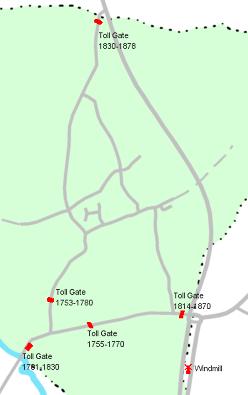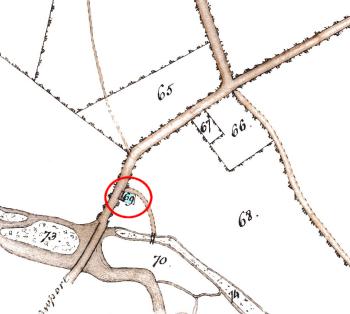
In the 18th and 19th Centuries turnpike trusts were set up for many stretches of road in England, in order to levy tolls on road users to pay for their upkeep. In 1753 Parliament agreed to the setting up of two turnpike trusts, one for the road from Bedford to Newport Pagnell and the other from the road from Kettering via Olney. The toll gates were to be erected at positions not more than one furlong to the east and north of the waypost at the junction of the two roads, north east of Sherington Bridge. To prevent traffic circumventing the toll gates by using side tracks, the trustees were empowered to close Blackbird Lane (previously known as Monchlade, running from Chicheley to Newport Pagnell) cutting off access to the windmill that had operated there for many years, which was then demolished. The trusts were to operate for the standard period of 21 years, but this was extended by another 5 years under the General Act of 1755.
However, the Bedford road ran into financial difficulties, and by 1770 its operations had been suspended. This meant the Kettering road trustees had to meet the full cost of maintaining Sherington Bridge, although traffic from Olney could now avoid their toll gate by proceeding along Gun Lane and then down Chicheley Hill. When their Trust came up for renewal in 1781, they received permission to move the toll gate to just north of the bridge. This was the position of the tollgate at the time of the 1796 Enclosure Map, which shows Plot 69 as being a 'Tollhouse and garden' owned by the Commissioners of the Turnpike Road. In the years 1800 to 1814, the Trust spent over £400 on maintenance of the bridge.

Meanwhile, the condition of the Bedford road, without a Turnpike Trust to maintain it, deteriorated and in 1814 Parliament set up a new Turnpike Trust. Their new toll gate was at the top of Chicheley Hill.
The upkeep of Sherington Bridge continued to be a problem and in 1815, the two trusts brought a bill of indictment for the bridge to be taken over by the County at the Aylesbury Assizes. An appeal to have the bridge re-built at public expense was successful. The new bridge opened in 1818.
The fact that there were now two tollgates on the Bedford road, one at the top of Chicheley Hill and one at the bottom by the bridge, caused resentment as people had to pay two tolls. In 1823, when the Kettering road trust came up for renewal (see below), Charles Penfold of Chicheley (and others) successfully petitioned Parliament to have the toll gate moved to its original position north of the road junction. To avoid the problem of people using Gun Lane as a detour recurring, the toll gate was subsequently moved to a position on Emberton Hill north of the Gun Lane junction.
The turnpikes operated for another 50 years or so. The Bedford road trust was wound up in 1870 and the Kettering road trust in 1878. The 1861 Census records the 'Turnpike' as one of the addresses.
Information from AC Chibnall's book "Sherington; Fiefs and Fields of a Buckinghamshire Village", Cambridge University Press, 1965.
1823 Act of Parliament - Click the image or page links to view

|
Page 1 Page 2 Page 3 Page 4 Page 5 Page 6 Page 7 Page 8 Page 9 Page 10 Page 11 Page 12 Page 13 Page 14 Page 15 Page 16 Page 17 |